
A VERY FAMOUS PIECE OF BONE
I had known about that bone, I had even seen it and taken a photo of it. But then, in some way, I lost almost all my pictures from the year 2012. So, when the great idea of "heygo" gave me the chance to revisit the National Museum of Slovenia, I didn't doubt even a second. We were led by the expert guidance of "mateja", who works as a guide in Ljubljana. But with all her knowledge she would also make a marvellous teacher in history.
Well, I make it short - here is the bone on the image to the right. You see it the same way as it is presented in the museum.
|
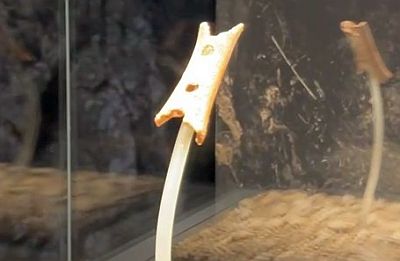
|
|
Yes, and? You may ask, because you see a broken bone with a couple of holes in it. True, it is a little broken, but in spite of that you may still play it. It is a flute and in the museum you can hear the sounds you can make with it. And if you consider, that the person, who made it, had very simple tools, you might appreciate it a little more. If you get to know, that it is 60.000 years old, you might appreciate it still even more. In the picture to the right there is a "new" model, but manufactured with the tools that people knew at that time.
|
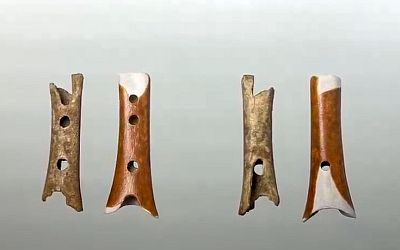
|
|
You notice that the old original had a third hole on top and also one on the backside. Now, this finding straightens out some questions about human history. Because this was done in a time, when our present form of mankind, the "homo sapiens sapiens" didn't exist yet. So it must have been a Neanderthal, who created this item. We have - of course - no pictures of the Neanderthals, apart from trying to rebuild faces from the form of their skulls. It is said that the fleeing forehead and the protruding bones under the eyebrows were typical. But most of all they were not thought to perform cultural activities.
|
 |
The cave paintings and the carvings of simple figurines, that we know of, are altogether younger and believed to be created by our own kind. So, the flute is not only the oldest evidence of human culture, it means also that we must reconsider history.
In the museum we are shown how to fabricate this kind of flute. You need a femur, the bone between thigh and knee, from some large animal, maybe from a cave bear. This animal is said to have been twice the size of our brown bears. If the bear rose onto its hindlegs, it would tower four or five meters above the man.
|
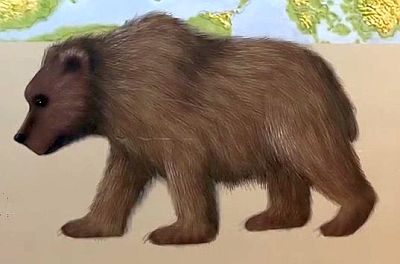 |
The Neanderthals lived in caves and it was in one of them, the Divje Babe Cave, an archeological team found the flute near a fire place, about 25 years ago. The fire was quite needed, as the temperature in the caves was quite steady throughout the year, but didn't differ to much from ten degrees Celsius. And as we assumed earlier, the flute was found under the head of a cave bear.
Divje Babe translated means "wild baby" or "wild woman", the latter of which often refers to witches. Therefore Divje Babe is also known as "Witch Cave".
|
Karel Dežman, to the right, was the first director of the museum we are visiting now. He is considered one of the fathers of modern archeology in Slovenia. He found also the pile dwellings on the Ljubljana Marsh, which you can see on the photo below. The settlers lived next to a lake, which varied greatly in height, being situated in the middle of a marsh. Therefore people built their houses on poles, in order to be save for floodings. They were inhabitated approximately from 3000 - 1500 BC.

|
 |
While in the museum, mateja, our guide, showed us some more very interesting artefacts. Two of those I shall mention, though this article is mainly about the flute. The first is a vessel, for holding fluid. On top it looks like the head of a bear, but the form of it is more like a woman. And into the figure the St. Andrews Cross is carved all over. But that is also a symbol of the constellation of Orion. It is very strange that this constellation appears in so many different old cultures all over the world. We find it in Egypt, in South America and even here in Europe. And everywhere it is mentioned in places, which are thousands of years old.
And, as nobody really knows, what to suggest about it, I'll give it a try: Erich von Däniken suggested in the Sixties, that our Earth was visited by Aliens, who influenced or maybe evolved our own societies. Däniken also points out, that Orion is a probable place for their origin. Why can't our vessel have been a sacred container, devoted to a Bear Goddess?
Yes, I know, that is a very wild theory, but it would at least fit together all three characteristics of the piece. Besides, this theory is not inferior to any other ...
|
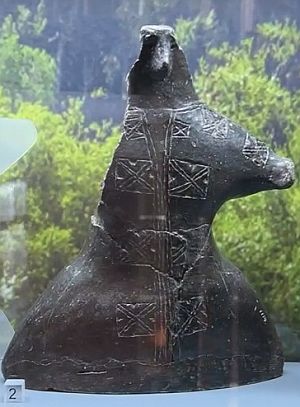 |
Finally our guide showed us another amazing exhibit. It are the rich findings from a female grave. All pieces of the jewelry are placed on the spot, where they were found on the body. It was probably a very high ranked woman, considering the many objects. On top there are two necklaces, then some armrings and then the lady had even rings on her legs. At the bottom of the grave there was plenty of food added, so that she wouldn't get hungry on her last journey.
Summing up, I spent another facinating hour with mateja on heygo. Thank you.
|
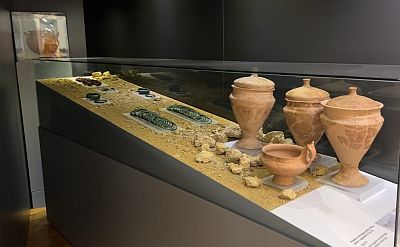 |
Copyright Bernhard Kauntz, Västerås 2022
Back to  or to the or to the  of of 
last update: 18.9.2022 by webmaster@werbeka.com
|

